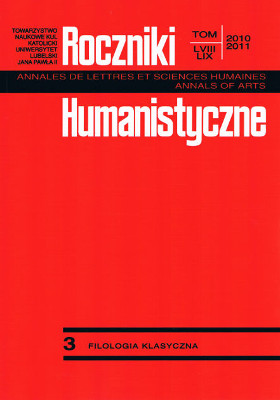Mosella by Decimus Magnus Ausonius as a Hodoeporicon
Abstract
The presented article is a summary of the M.A. thesis entitled: Mosella by Decimus Magnus Ausonius as a hodoeporicon. The main assumption of the work is an attempt to establish the meaning of the term hodoeporicon/iter and to find its features in Ausonius’ Mosella. Difficulties in doing a research on this subject are caused by a scarce number of studies concerning this issue. In the article, the definition of hodoeporicon is based on three principal works written by J.C. Scaliger, J. Schnayder and R. Krzywy. A piece of literary work might be called hodoeporicon/ iter, if it is a sort of a report from a journey created in a form of a poem or a work of prose. It should give the names of the visited places, contain information about them, e.g. topography, hydrography, wildlife, a description of the inhabitants, their customs, religion and habits, and also architecture of the regions. Another elements of iter are the mythology and digressions placed by the author in order to display his education. The deeper analysis of some parts of the Mosella seems to demonstrate mainly the features of the iter presented above.
References
Cytowska M.: Hodoeporikon w literaturze polsko- łacińskiej, „Meander” 4 (1966), s. 127-137.
Głowiński M.: Gatunek literacki i problemy poetyki historycznej, (Problemy Teorii Literatury, t. 2), Wrocław 1976, s. 109-129.
Gzella S.: Decimus Magnus Ausonius. Zapoznany piewca przyrody, „Filomata” 1977, nr 309, s. 379-400.
Korzeniewski D.: Aufbau und Struktur der Mozella des Ausonius, „Rheinisches Museum” 106 (1963), s. 80-95.
Krzywy R.: Od hodoeporikonu do eposu peregrynackiego. Studium z historii form literackich, Warszawa: Uniwersytet Warszawski, Wydział Polonistyki 2001.
Marx F.: Ausonis’ Lied von der Mosel, „Rheinisches Museum” 80 (1931), s. 368-392.
Matakiewicz H.: De itineris genere litterario, „Eos” 32 (1929), s. 229-245.
Newlands C.: Naturae mirabor opus: Ausonius’ challenge to Statius in the Mosella, „Transactions of the American Philological Association” 118 (1988), s. 403-419.
Roberts M.: The Mosella of Ausonius: an Interpretation, „Transactions of the American Philological Association” 114 (1984), s. 343-353.
Scaliger I.C.: Poetices libri septem. Sieben Bücher über die Dichtkunst, t. 3, Stuttgart–Bad Cannstatt: Frommann-Holzboog 1995, s. 110-116.
Schnayder J.: De itineraris poematis Romanorum, Łódź: Societas Scientiarum Lodziensis 1953.
Schnayder J.: Iter, „Zagadnienia Rodzajów Literackich” 1 (1958), s. 208-210.
Schnayder J.: Periegeza w literaturze greckiej. Powstanie i rozwój gatunku, (Archiwum Filologiczne PAN, t. 19), Kraków: PAN 1946.
Simms D.L.: Water- Driven saws, Ausonius, and the authenticity of the Mosella, „Technology and Culture” 24 (1983), s. 635-643.
Sivan H.: Redating Ausonius’ Moselle, „American Journal of Philology” 3 (1990), s. 383-394.
Słownik literatury staropolskiej, red. T. Michałowska, Wrocław–Warszawa: Zakład Narodowy im. Ossolińskich 1990, s. 268-269.
Szelest H.: Die Mosella des Ausonius und ihre literarische Tradition, „Eos” 75 (1987), s. 95-96.
Wild P.S.: Ausonius, A Fourth Century Poet, „The Classical Journal” 46 (1951), z. 8, s. 373-382.
Copyright (c) 2011 Roczniki Humanistyczne

This work is licensed under a Creative Commons Attribution-NonCommercial-NoDerivatives 4.0 International License.





